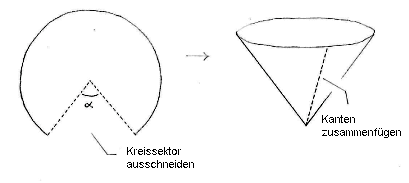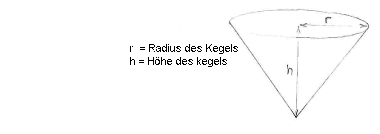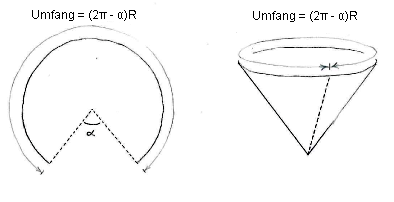Lösung 1.3:7
Aus Online Mathematik Brückenkurs 2
| Zeile 54: | Zeile 54: | ||
::Maximiere <math>V(\alpha) = \frac{1}{3}\pi R^3 \Bigl(\frac{2\pi-\alpha}{2\pi} \Bigr)^2\sqrt{1-\Bigl(\frac{2\pi-\alpha}{2\pi}\Bigr)^2}\,</math>, wo <math>0\le \alpha \le 2\pi\,</math>. | ::Maximiere <math>V(\alpha) = \frac{1}{3}\pi R^3 \Bigl(\frac{2\pi-\alpha}{2\pi} \Bigr)^2\sqrt{1-\Bigl(\frac{2\pi-\alpha}{2\pi}\Bigr)^2}\,</math>, wo <math>0\le \alpha \le 2\pi\,</math>. | ||
| - | Bevor wir anfangen die Funktion abzuleiten, sehen wir, dass | + | Bevor wir anfangen die Funktion abzuleiten, sehen wir, dass der Winkel |
<math>\alpha</math> nur in | <math>\alpha</math> nur in | ||
<math>(2\pi-\alpha)/2\pi</math>-Termen auftritt, um das Problem zu vereinfachen, können wir das Volumen genauso in Bezug auf die Variable <math>x=(2\pi-\alpha)/2\pi</math> maximieren. | <math>(2\pi-\alpha)/2\pi</math>-Termen auftritt, um das Problem zu vereinfachen, können wir das Volumen genauso in Bezug auf die Variable <math>x=(2\pi-\alpha)/2\pi</math> maximieren. | ||
| - | ::Maximiere <math>V(x) = \frac{1}{3}\pi R^3x^2\sqrt{1-x^2}\,</math>, | + | ::Maximiere <math>V(x) = \frac{1}{3}\pi R^3x^2\sqrt{1-x^2}\,</math>, für <math>0\le x\le 1\,</math>. |
| - | Wenn <math>x=0</math> oder <math>x=1</math>, ist | + | Wenn <math>x=0</math> oder <math>x=1</math> ist, ist das Volumen null, weil die Funktion überall (außer in <math>x=1</math>) differenzierbar ist, nimmt das Volumen sein Maximum in einem stationären Punkt an. |
Wir leiten die Funktion ab, | Wir leiten die Funktion ab, | ||
| Zeile 74: | Zeile 74: | ||
\end{align}</math>}} | \end{align}</math>}} | ||
| - | Die Ableitung ist null wenn <math>x=0</math> (dies ist | + | Die Ableitung ist null wenn <math>x=0</math> (dies ist ein Raandpunkt) oder wenn <math>2-3x^2=0</math> ist, also wenn <math>x=\sqrt{2/3}\,</math>. (Der Punkt <math>x=-\sqrt{2/3}</math> liegt außerhalb des Gebietes <math>0\le x\le 1</math>.) |
Durch einer Vorzeichentabelle erhalten wir die Vorzeichen der Faktoren, | Durch einer Vorzeichentabelle erhalten wir die Vorzeichen der Faktoren, | ||
| Zeile 137: | Zeile 137: | ||
|} | |} | ||
| - | Wir sehen hier dass <math>x=\sqrt{2/3}</math> ein globales | + | Wir sehen hier dass <math>x=\sqrt{2/3}</math> ein globales Maximum ist. <math>x = \sqrt{2/3}</math> entspricht den Winkel <math>\alpha</math>: |
| - | {{Abgesetzte Formel||<math>\sqrt{\frac{2}{3}}=\frac{2\pi-\alpha }{2\pi}\quad \Leftrightarrow\quad \alpha = 2\pi \bigl(1-\sqrt{2/3}\,\bigr)\ | + | {{Abgesetzte Formel||<math>\sqrt{\frac{2}{3}}=\frac{2\pi-\alpha }{2\pi}\quad \Leftrightarrow\quad \alpha = 2\pi \bigl(1-\sqrt{2/3}\,\bigr)\ </math>}} |
Version vom 10:50, 6. Aug. 2009
Wie der Kegel gebaut wird, ist hier illustriert:
Nachdem wir den Volumen des Kegels maximieren wollen, betrachten wir nun die Maße Kegels.
Mit diesen Maßen ist das Volumen des Kegels:
| \displaystyle \begin{align}
V &= \frac{1}{3}\text{(Fläche des Kreises)}\cdot\text{(Höhe)}\\[5pt] &= \frac{1}{3}\pi r^{2}h\,\textrm{.} \end{align} |
Wir müssen jetzt den Radius \displaystyle r und die Höhe \displaystyle h durch den Winkel \displaystyle \alpha ausdrücken, sodass wir das Volumen \displaystyle V als Funktion von \displaystyle \alpha schreiben können.
Schneiden wir einen Kreissektor mit dem Winkel \displaystyle \alpha aus dem Kreis, ist der Umfang des übriggebliebenen Kreissegments \displaystyle (2\pi-\alpha)R sein, wobei \displaystyle R der ursprüngliche Radius ist.
Der Umfang des oberen Kreises ist aber auch \displaystyle 2\pi r, also haben wir
| \displaystyle 2\pi r = (2\pi-\alpha)R\quad\Leftrightarrow\quad r = \frac{2\pi -\alpha}{2\pi}\,R\,\textrm{.} |
Jetzt haben wir den neuen Radius \displaystyle r als Funktion des Winkels \displaystyle \alpha und dem ursprünglichen Radius \displaystyle R ausgedrückt.
Um die Höhe zu bestimmen, benutzen wir den Satz des Pythagoras
Also haben wir
| \displaystyle \begin{align}
h &= \sqrt{R^2-\Bigl(\frac{2\pi-\alpha}{2\pi}\,R\Bigr)^2}\\[5pt] &= \sqrt{R^2-\Bigl(\frac{2\pi-\alpha}{2\pi}\Bigr)^2R^2}\\[5pt] &= R\sqrt{1-\Bigl(\frac{2\pi-\alpha}{2\pi}\Bigr)^2}\,\textrm{.} \end{align} |
Jetzt haben wir den Radius \displaystyle r und die Höhe \displaystyle h als Funktionen von \displaystyle \alpha und \displaystyle R, geschrieben. Das Volumen des Kegels ist also
| \displaystyle \begin{align}
V &= \frac{1}{3}\pi r^2 h\\[5pt] &= \frac{1}{3}\pi \Bigl(\frac{2\pi-\alpha}{2\pi}R\Bigr)^2 R\sqrt{1-\Bigl( \frac{2\pi-\alpha}{2\pi}\Bigr)^2}\\[5pt] &= \frac{1}{3}\pi R^3\Bigl(\frac{2\pi-\alpha}{2\pi}\Bigr)^2 \sqrt{1-\Bigl(\frac{2\pi-\alpha}{2\pi}\Bigr)^2}\,\textrm{.} \end{align} |
Unser Problem ist jetzt:
- Maximiere \displaystyle V(\alpha) = \frac{1}{3}\pi R^3 \Bigl(\frac{2\pi-\alpha}{2\pi} \Bigr)^2\sqrt{1-\Bigl(\frac{2\pi-\alpha}{2\pi}\Bigr)^2}\,, wo \displaystyle 0\le \alpha \le 2\pi\,.
Bevor wir anfangen die Funktion abzuleiten, sehen wir, dass der Winkel \displaystyle \alpha nur in \displaystyle (2\pi-\alpha)/2\pi-Termen auftritt, um das Problem zu vereinfachen, können wir das Volumen genauso in Bezug auf die Variable \displaystyle x=(2\pi-\alpha)/2\pi maximieren.
- Maximiere \displaystyle V(x) = \frac{1}{3}\pi R^3x^2\sqrt{1-x^2}\,, für \displaystyle 0\le x\le 1\,.
Wenn \displaystyle x=0 oder \displaystyle x=1 ist, ist das Volumen null, weil die Funktion überall (außer in \displaystyle x=1) differenzierbar ist, nimmt das Volumen sein Maximum in einem stationären Punkt an.
Wir leiten die Funktion ab,
| \displaystyle V'(x) = \frac{1}{3}\pi R^3\cdot 2x\cdot \sqrt{1-x^2} + \frac{1}{3}\pi R^3x^2\cdot\frac{1}{2\sqrt{1-x^2}}\cdot (-2x)\,, |
und vereinfachen den Ausdruck, indem wir so viele Faktoren wir möglich herausziehen,
| \displaystyle \begin{align}
V'(x) &= \frac{2}{3}\pi R^3x\sqrt{1-x^2} - \frac{1}{3}\pi R^3x^3\frac{1}{\sqrt{1-x^2}}\\[5pt] &= \frac{1}{3}\pi R^3\frac{x}{\sqrt{1-x^2}}\bigl[ 2(1-x^2)-x^2\bigr]\\[5pt] &= \frac{1}{3}\pi R^3\frac{x}{\sqrt{1-x^2}}(2-3x^2)\,\textrm{.} \end{align} |
Die Ableitung ist null wenn \displaystyle x=0 (dies ist ein Raandpunkt) oder wenn \displaystyle 2-3x^2=0 ist, also wenn \displaystyle x=\sqrt{2/3}\,. (Der Punkt \displaystyle x=-\sqrt{2/3} liegt außerhalb des Gebietes \displaystyle 0\le x\le 1.)
Durch einer Vorzeichentabelle erhalten wir die Vorzeichen der Faktoren,
| \displaystyle x | \displaystyle 0 | \displaystyle \sqrt{\tfrac{2}{3}} | \displaystyle 1 | ||
| \displaystyle x | \displaystyle 0 | \displaystyle + | \displaystyle + | \displaystyle + | \displaystyle + |
| \displaystyle \sqrt{1-x^2} | \displaystyle + | \displaystyle + | \displaystyle + | \displaystyle + | \displaystyle 0 |
| \displaystyle 2-3x^2 | \displaystyle + | \displaystyle + | \displaystyle 0 | \displaystyle - | \displaystyle - |
und erhalten dadurch das Vorzeichen der Ableitung selbst
| \displaystyle x | \displaystyle 0 | \displaystyle \sqrt{\tfrac{2}{3}} | \displaystyle 1 | ||
| \displaystyle V'(x) | \displaystyle 0 | \displaystyle + | \displaystyle 0 | \displaystyle - | |
| \displaystyle V(x) | \displaystyle 0 | \displaystyle \nearrow | \displaystyle \tfrac{4}{9\sqrt{3}}\pi R^3 | \displaystyle \searrow | \displaystyle 0 |
Wir sehen hier dass \displaystyle x=\sqrt{2/3} ein globales Maximum ist. \displaystyle x = \sqrt{2/3} entspricht den Winkel \displaystyle \alpha:
| \displaystyle \sqrt{\frac{2}{3}}=\frac{2\pi-\alpha }{2\pi}\quad \Leftrightarrow\quad \alpha = 2\pi \bigl(1-\sqrt{2/3}\,\bigr)\ |




